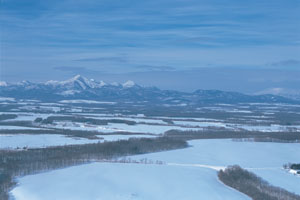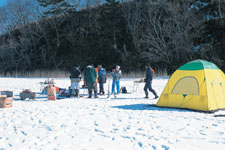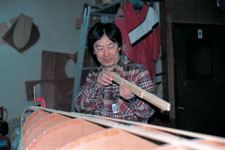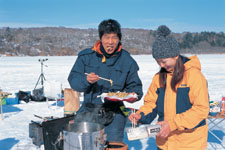Upfront: A Hollow Hokkaido
Back to Contents of Issue: May 2004
|
|
|
|
by Lucille Craft |
|
|
Streets bristle with slogans demanding the return of territories grabbed by Russia in 1945. A gleaming state-of-the-art memorial hall to the lost islands, built by the prefectural government, sits in lavish contrast to the shabby commercial district. Meanwhile, the overtaxed seas around Nemuro yield fewer fish every year. The country's last coal mine, in neighboring Kushiro, closed for good two years ago. Trains, chopped down to just two cars, rarely stop nowadays; schools are being shuttered. And for every new resident, one or two leave.
Nemuro's obsession with the past is extreme, but economic distress is a tune being played out across Japan's northern island. A whopping three-quarters of Hokkaido towns are classified as "hollowed out," and the decade-old malaise has triggered a brain drain. Elite graduates once moved lockstep into the prefectural civil service or Hokkaido Takushoku Bank (Takugin), formerly one of the country's leading banks. But with Takugin's spectacular collapse in 1997 and the prefectural government struggling to downsize, the island's best and brightest have few reasons to stay.
"Our greatest problem," says Isao Hara, chairman of a Sapporo-based private think tank, "is unemployment." A chain of business failures stemming from the Takugin bankruptcy, the demise of coal mining, mad-cow disease and the contraction in Hokkaido's lifeline, public works spending, have left 5.6 percent of Hokkaido's workers, or 1,660,000, unemployed. "And," warns forecaster Hara, "it's going to get worse."
Hokkaido residents were mostly bystanders as their once-lovely and leafy island was beset by developers with a track record for failure. "The government excelled at bulldozing, and was lousy at promoting tourism," notes tourism expert Takahiro Wanouchi in his book Problems Facing Hokkaido. The orgy of building reached its apogee in the 1990s, with big-ticket theme parks such as Gluck's Kingdom -- a re-creation of medieval Germany that met a very Grimm ending in 2002 -- and Canadian World, which lasted for a mere seven years.
Given the depths of despair which Hokkaido finds itself in, there is surprising bullishness about the island's potential. In his book, A Vision of How Hokkaido will be Five Years From Now, Sapporo University professor Koyata Washida spares no exclamation points. "Hokkaido will change! ... Hokkaido will change Japan!" Among his suggestions for ghostly ex-mining towns like Yubari, for instance, are courting city dwellers seeking the pastoral lifestyle.
Futurist Isao Hara reckons Hokkaido will never be completely self-sufficient, but that costs could be slashed, public services improved and population imbalances accordingly eased by aggressively whittling the island's existing 212 villages, towns and cities down to about 25 localities of at least 150,000 residents each. He envisions high-tech partnerships betweeen some of the island's university biotech labs and private sector, and a free trade zone. "Hokkaido is more open to expats and easier to live in" than the rest of Japan, he argues.
Pundits and bureaucrats alike agree that Hokkaido's dramatic natural assets have been squandered and that bland, cookie-cutter resorts dictated by developers 500 miles away in Tokyo are not the best way to attract tourists. This new thinking has permeated even the bleak streets of Nemuro. In a shrinking town so desolate even Starbucks and McDonald's dare not tread, for all Nemuro's fixation with what might have been, there are a few positive signs of what could be.
|
|
Note: The function "email this page" is currently not supported for this page.


 Nemuro, Hokkaido: Windy and weatherbeaten, this slender slice of northeastern Japan surrenders to snow and ice much of the year. But in mind-set, the town of 33,000 has been frozen for decades.
Nemuro, Hokkaido: Windy and weatherbeaten, this slender slice of northeastern Japan surrenders to snow and ice much of the year. But in mind-set, the town of 33,000 has been frozen for decades.
 With a climate and topography closer to that of Topeka than Tokyo, Hokkaido residents are fond of comparing themselves to Americans, blessed with an un-Japanese "frontier spirit" inherited from hardy ancestors who came north in the late 19th century to fish, farm, log and dig coal. This mythology holds that the frontier spirit was extinguished in 1950, with the creation of the (evil) Hokkaido Development Authority. To accelerate development of its far-flung regions, Hokkaido and Okinawa, Japan's central government set up agencies to build scores of big-ticket dams, bridges, ports and roads. (Author Koyata Washida claims the agency was a high-handed ruling party ploy to squeeze out an emerging socialist government in postwar Hokkaido.) Public works orgies were being staged, of course, from Kyoto to Shikoku, but in Hokkaido's case, the long-term effects arguably were far more pernicious. Hokkaido's special treatment is widely seen as the root of its current predicament, having turned the island of six million from pioneering Daniel Boones into passive welfare queens.
With a climate and topography closer to that of Topeka than Tokyo, Hokkaido residents are fond of comparing themselves to Americans, blessed with an un-Japanese "frontier spirit" inherited from hardy ancestors who came north in the late 19th century to fish, farm, log and dig coal. This mythology holds that the frontier spirit was extinguished in 1950, with the creation of the (evil) Hokkaido Development Authority. To accelerate development of its far-flung regions, Hokkaido and Okinawa, Japan's central government set up agencies to build scores of big-ticket dams, bridges, ports and roads. (Author Koyata Washida claims the agency was a high-handed ruling party ploy to squeeze out an emerging socialist government in postwar Hokkaido.) Public works orgies were being staged, of course, from Kyoto to Shikoku, but in Hokkaido's case, the long-term effects arguably were far more pernicious. Hokkaido's special treatment is widely seen as the root of its current predicament, having turned the island of six million from pioneering Daniel Boones into passive welfare queens.
 Beating up on the much-maligned Hokkaido Development Agency (later consolidated into the Ministry of Land, Infrastructure and Transport) though, while perhaps soothing to the soul, now serves little practical purpose: Prime Minister Koizumi has already announced the central government can't afford to keep the gravy train going, and in line with a nationwide decentralization reform, has ordered Hokkaido to start thinking for itself. Ex-central government technocrat and now Hokkaido governor, Harumi Takahashi, is slated to announce a package of measures this spring to start weaning the troubled island off central subsidies. She has promised to spur tourism, shift from pure commodity agriculture to high-value-added, and foster IT and biotechnology.
Beating up on the much-maligned Hokkaido Development Agency (later consolidated into the Ministry of Land, Infrastructure and Transport) though, while perhaps soothing to the soul, now serves little practical purpose: Prime Minister Koizumi has already announced the central government can't afford to keep the gravy train going, and in line with a nationwide decentralization reform, has ordered Hokkaido to start thinking for itself. Ex-central government technocrat and now Hokkaido governor, Harumi Takahashi, is slated to announce a package of measures this spring to start weaning the troubled island off central subsidies. She has promised to spur tourism, shift from pure commodity agriculture to high-value-added, and foster IT and biotechnology.
 (Washida certainly knows a thing or two about boosting bottom lines: His breezy, Up With People style has sold over the last 25 years an amazing 140 titles, like Speed Thinking, Finding What You Want To Do, Easing Relationships, and the intriguing How to become a College Professor. Trained not in economics but philosophy, he seems to have acquired capitalist leanings since his first book in 1978, Modern Marx Theory.)
(Washida certainly knows a thing or two about boosting bottom lines: His breezy, Up With People style has sold over the last 25 years an amazing 140 titles, like Speed Thinking, Finding What You Want To Do, Easing Relationships, and the intriguing How to become a College Professor. Trained not in economics but philosophy, he seems to have acquired capitalist leanings since his first book in 1978, Modern Marx Theory.)
 Every year for the last eight, the struggling town has emptied its pockets to heavily subsidize a backpacker's ecotour, highlighting the wilderness, local culture and farm life for visitors from the Tokyo area. For less than the cost of airfare, tourists are treated to a frenzied five-day marathon of canoe-building, ice fishing for pond smelt, barbeques on frozen lakes, horsebacking riding, bird-watching for rare eagles and cranes, milking cows, riding tractors, getting interviewed by the local FM station, and drinking sake with the locals. A tiny group of aspiring ecotour guides, who call themselves Rakuru after the Ainu word for "fog," design and run the gauntlet of activities in partnership with the town's two-man ecotourism promotion bureau. For all its rough edges, the experimental tour has earned raves from its participants and perfectly demonstrates that Hokkaido has plenty of leveragable natural assets, good ideas and manpower. Now all it needs to do is to get the prototypes out of the laboratory.
@
Every year for the last eight, the struggling town has emptied its pockets to heavily subsidize a backpacker's ecotour, highlighting the wilderness, local culture and farm life for visitors from the Tokyo area. For less than the cost of airfare, tourists are treated to a frenzied five-day marathon of canoe-building, ice fishing for pond smelt, barbeques on frozen lakes, horsebacking riding, bird-watching for rare eagles and cranes, milking cows, riding tractors, getting interviewed by the local FM station, and drinking sake with the locals. A tiny group of aspiring ecotour guides, who call themselves Rakuru after the Ainu word for "fog," design and run the gauntlet of activities in partnership with the town's two-man ecotourism promotion bureau. For all its rough edges, the experimental tour has earned raves from its participants and perfectly demonstrates that Hokkaido has plenty of leveragable natural assets, good ideas and manpower. Now all it needs to do is to get the prototypes out of the laboratory.
@ 



